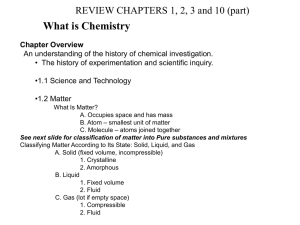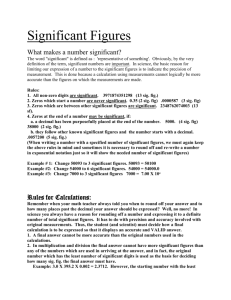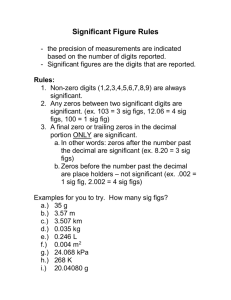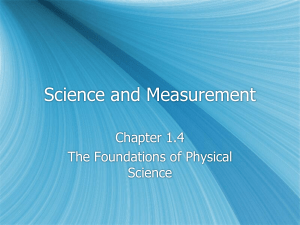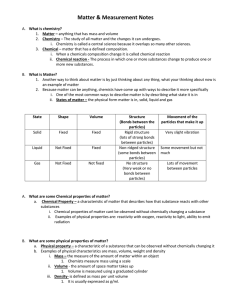Review 1 (Chapters 1, 2, 4)
advertisement
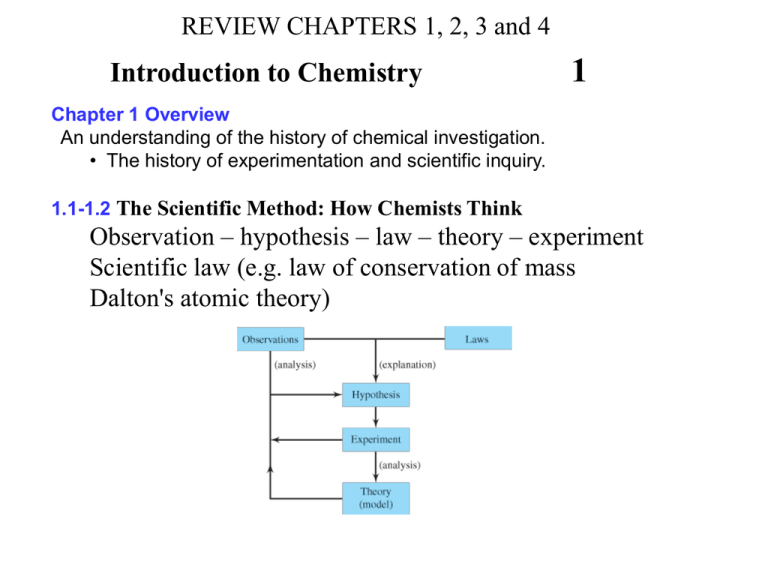
REVIEW CHAPTERS 1, 2, 3 and 4 Introduction to Chemistry 1 Chapter 1 Overview An understanding of the history of chemical investigation. • The history of experimentation and scientific inquiry. 1.1-1.2 The Scientific Method: How Chemists Think Observation – hypothesis – law – theory – experiment Scientific law (e.g. law of conservation of mass Dalton's atomic theory) 1.3 Matter What Is Matter? A. Occupies space and has mass B. Atom – smallest unit of matter C. Molecule – atoms joined together 1.4 Classifying Matter According to Its State: Solid, Liquid, and Gas A. Solid (fixed volume, incompressible) strongest attractive forces 1. Crystalline 2. Amorphous B. Liquid- Medium inter molecular forces of attraction 1. Fixed volume 2. Fluid C. Gas (lot if empty space) 1. Compressible 2. Fluid 3. No attractive forces Classifying Matter Section 1.4 Numerical Side of Chemistry 2 Chapter Overview A cornerstone of the chemical sciences, the manipulation of numbers and their associated units. Measurement accuracies, significant figures, rounding and scientific notation. 2.1 Scientific Notation: Writing Big and Small Numbers A. Shorthand notation for numbers B. Two main pieces: decimal and power-of-10 exponent C. Measured value does not change, just how you report it (550.6 to 1 sig fig?) 2.2, 2.4 Numbers in chemistry–Units and precision and accuracy in reporting it; Uncertainty in measurement, last digit on the right is uncertain 2.3 Significant Figures: Writing Numbers to Reflect Position A. How many digits can I report? How many should I report? B. Certain digits and estimated digits C. Counting significant figures 1. All nonzero digits are significant 1234 = 4 Sig fig 2. Interior zeros are significant 505 = 3 sig fig 3. Trailing zeros after a decimal are significant 55.00 = 4 sig fig 4. Leading zeros are not significant 0.012 = 2 sig fig 5. Zeros at the end of a number, without a decimal point, are ambiguous 150 = 2 SF D. Exact numbers/definition, conversion factors have infinite sig fig. 2.4 Significant Figures in Calculations A. Multiplication and division: Result carries as many significant digits as the factor with the fewest significant digits B. Rounding 1. If leftmost dropped digit is 4 or less, round down (leave it same) 2. If leftmost dropped digit is 5 or higher, round up (increment it by 1) C. Addition and Subtraction Result carries as many decimal places as the quantity with the fewest decimal places D. Calculations Involving Both Multiplication/Division and Addition/Subtraction 1. Do steps in parentheses first 2. Determine the number of significant figures in intermediate answer 3. Do remaining steps 2.5 The Basic Units of Measurement A. English, metric, SI B. SI Units (Mass – kg; Length – m; Time – sec) C. Prefix Multipliers milli (m) 0.001 centi (c) 0.01 kilo (k) 1000 Mega (M) 1,000,000 D. Derived Units 1. Area – cm2 2. Volume – cm3 or L Common Prefixes in the SI System MEMORIZE Prefix Symbol Decimal Equivalent Power of 10 1,000,000 Base x 106 1,000 Base x 103 mega- M kilo- k deci- d 0.1 Base x 10-1 centi- c 0.01 Base x 10-2 milli- m 0.001 Base x 10-3 micro- m or mc 0.000 001 Base x 10-6 nano- n 0.000 000 001 Base x 10-9 2.6 Converting from One Unit to Another (UNIT 1 to UNIT 2) A. Units are important, most numbers get one B. Include units in all calculations C. Conversion factors (Unit you have comes in the bottom, unit you want comes in the TOP) Unit 1 X Unit 2 = UNIT 2 Unit 1 D. Significant figure of the final answer depends on UNIT 1 given in problem NOT the sig. fig of the conversion factor Solving Multistep Conversion Problems A. Understand where you are going first B. Not all calculations can be done in one step Units Raised to a Power A. 1 inch = 2.54 cm so 1 inch3 = (2.54 cm)3 = 16.4 cm3 2.7 Temperature: Random Molecular and Atomic Motion A. Fahrenheit (F) B. Celsius (C) C. Kelvin (K) Conversions F - 32 C K C 273 2.8 (1.8 C) 32 F 1.8 Density = Mass/Volume; Remember Mass is in grams, volume in mL or cm3 Unit of density = g/mL or g/cm3 Atoms and Elements 3.1 3 ELEMENTS A. Atoms make up all matter B. ~91 different naturally occurring elements 1. Each element is composed of tiny indestructible particles called atoms 2. All atoms of a given element have the same mass and other properties that distinguish them from atoms of other elements 3. Atoms combine in simple, whole-number ratios to form compounds 3.3, 3.4 Names vs symbols of elements- Memorize List from web Metal, non-metals, metalloids - 3.5 and 3.6 Looking for Patterns: The Periodic Law and the Periodic Table A. Mendeleev (1834 - 1907) B. Periodic law C. Metals (usually loose electrons to form cations) D. Nonmetals (usually gains electrons to form anions) E. Metalloids, also known as semiconductors F. Individual group names 1. Group 1 – alkali metals +1 ion only 2. Group 2 – alkali earth metals +2 ion only 3. Group 7 – halogens usually –1 ion 4. Group 8 – noble gases 3.7 Elements which are diatomics N2 O2 F2 Cl2 Br2 I2 and H2 3.8 Ionic compound – It must conatin a metal, Meatl forms + ion CATIONS Nonmatels form – charge ions ANIONS 3.9 Number of atoms in a chemical formula 4 Properties of Matter Section 4.1-4.2 How We Tell Matter Apart: Physical and Chemical Properties A. Physical property 1. Observable without changing the identity 2. Melting point, odor, color B. Chemical property 1. Observable only by changing the identity-Chemical reactions 2. Flammability How Matter Changes: Physical and Chemical Changes A. Physical change 1. Appearance and properties can change 2. Composition does not change B. Chemical change 1. Appearance and properties can change 2. Composition changes Section 4.3 Separation of mixtures through physical changes 1. Decanting 2. Distillation 3. Filtration Section 4.4 Energy A. Energy cannot be created or destroyed B. Units of energy and heat 1. Joule (J) 2. calorie (cal) (1 cal = 4.184J) 3. Calorie (Cal) (1Cal = 1000cal = 1kcal) 4. Kilowatt-hour (kWh)- - Will not be used in CHE100 Exothermic Process: Heat is Released by a system or process Heat q = negative; Here products are lower energy than reactants Endothermic Process: Heat is Absorbed by a system or process Heat q = positive; Here products are HIGHER energy than reactants Section 4.5 Heat, Specific heat The specific heat of a substance is the quantity of heat required to change the temperature of 1 g of that substance by 1ºC units J/gºC Specific heat of water very high Specific heat of metals are low, hence are good conductors of heat Heat = mass of substance X Sp. Heat X Change in temp = M S DT 2 body problem Heat lost by hot object = heat gained by cold object Read definitions of Specific heat (cal/gºC) meaning of it Specific of heat of water = 1cal/g ºC = 4.184J/g ºC EXAM 1- 100 POINTS 10 points Bonus question!! Part 1 Multiple Choice –Show calculations for partial/full credit 20 questions- chapters (1-4) Part 2 Fill in the Blanks scientific notation, chemical change, physical change, chemical and physical properties, Pure substances and mixtures, Simple Conversions –show all work and Density, calories problem Bonus question:
